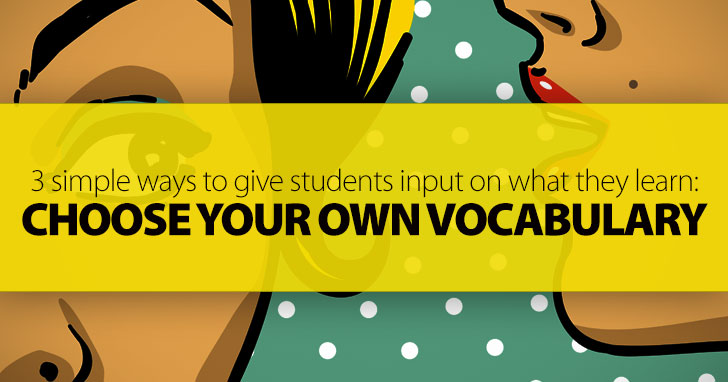Choose Your Own Vocabulary: 3 Simple Ways to Give Students Input on What They Learn


When you are teaching English as a second language, vocabulary is an area your students will always need to expand. Beginning students may not know where to start with vocabulary, and as students progress their vocabulary lists become more complicated and specific. Sometimes as a teacher, though, it can be confusing or frustrating to know which words to teach. What do your students know? What do they need to know? Here are several different approaches to designing and teaching a vocabulary unit from scratch.

A k/w/l (Know/Want to Know/Learned) chart is sometimes the best place to start when teaching a new topic to your students. Start by having students work in groups or lead the whole class in discussion. Give your students the topic you will be teaching. For example, sports, food, careers, travel – these or more specific topics often serve as the basis for a vocabulary unit. Then brainstorm with your students or have them work together in groups to make a list of what they already know about the topic. Student knowledge will vary. Some will know more than others, and some will know things that no one else does. Still others may have little to no knowledge on the topic at all. Once you have a compilation of what your students as a group already know, ask them what they still want to know about the topic. You can make a list of questions and note any vocabulary related to those questions. Then, between your two lists, you should have a good set of vocabulary from which to draw. You might want to include all of the topic related words or only some of them in your unit. You can also add other words related to the topic that you think they should know but didn’t come up in your conversation. Working together should help you compile a collection of words from which to choose your vocabulary unit.
An idea web is a familiar way to start writing, but you can use a similar method to come up with words for a vocabulary unit. Though you can do this activity with your students, it is probably more productive to do it on your own. Start by writing your topic in the middle of the page, and then draw spokes off of it (as if your topic was the center of a wheel). At the end of each spoke, write a word that relates to the topic. Then draw spokes off of each of the secondary words, and add more detailed vocabulary related to each of those. Continue until you feel you have exhausted the topic and the subtopics; then step back and look at your words. Choose the ones you think would be most useful for your students. Include some easier words, some more complicated words, and also some which will present a challenge. Then use these words as the material for your vocabulary unit.
Sometimes learning words in context makes them easier to remember; in fact, that is usually the case. So starting with a video or written piece may be the best way to come up with your vocabulary unit. Like other vocabulary unit activities, you can do this with your students or on your own. Start with a written piece – a newspaper article, a short story or an excerpt from a longer piece. (This is also a great way to bring realia into the classroom.) Then, read through it noting any words your students either don’t know or don’t know well. Look for uncommon words, complicated words, words that are essential for understanding the meaning of the text, or words centering around the theme or subject of the piece. Make a list of these words. Once you have finished reading and analyzing the piece, look at your list and make any additions or subtractions you think are necessary. You can include synonyms or antonyms of your words as well. You can also follow the same process with a video if you choose. Either use a transcript or make notes as you listen to compile a similar vocabulary list. Now that you have your vocabulary words selected, present them and the original source to your students.
In a similar vein, pictures can also be a great starting point for creating a vocabulary unit. I love the pictures in I-Spy style books that are packed with items often related to each other. Picture dictionaries also provide great resources for creating a vocabulary unit. You can also use pictures of real life, tourist photos, or photo essays. Try National Geographic Magazine for some striking pictures all centered around one theme. Identify items in whatever picture(s) you choose to use. Don’t forget to look for verbs that are happening in the pictures as well. Make a list, and then add related words. You now have your vocabulary unit and a theme around which it centers.
Sometimes curriculum standards make our lives as teachers easier, and sometimes they make them more complicated. Whatever your opinion of curriculums today, vocabulary units are often already a part of the material for a given course. In my experience, curriculum designated vocabulary units center around a theme most of the time, and that can be a great place to start when compiling your own vocabulary units. Look at the list as it stands, and then think about areas that are not represented in the list. You may decide to add synonyms or antonyms or other related words. It’s okay to expand these dictated units, though not always okay to take away from them.
Whatever method works best for you, remember that you can always change, add or remove from a vocabulary list according to your preferences. I love to teach groups of words or vocabulary families whenever I can, and I find that students learn well that way. Whatever method you decide to use, give your students a chance to guess the meaning of words from context, give them recognition tasks, and then give them production tasks with your vocabulary unit. If you do, they are sure to come away from your class with lots of practical knowledge and an expanded vocabulary to boot.